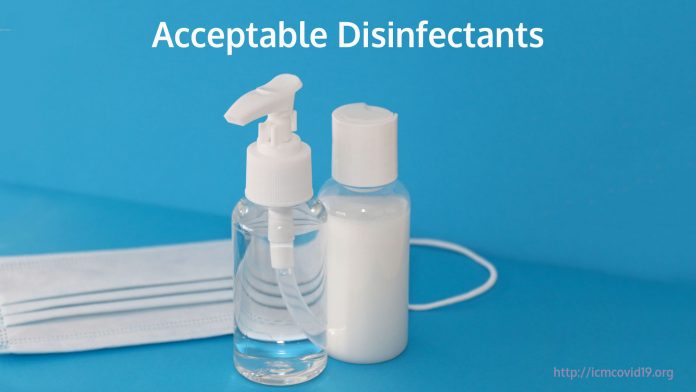Introduction
This page provides guidance on environmental cleaning in healthcare and non-healthcare settings during the COVID-19 pandemic.
It is essential to establish procedures for the correct disinfection of environments that could have been contaminated with SARS-CoV-2.
Disinfectants
In general, alcohol-based disinfectants (ethanol, propan-2-ol, propan1-ol) have been shown to significantly reduce infectivity of enveloped viruses like SARS-CoV-2, in concentrations of 70-80% with one minute exposure time. However, ethanol has not yet been approved under the BPR, so biocidal products based on ethanol are not authorised under the BPR but are available under transitional measures.
Cleaning options for healthcare settings after the management of a suspected or confirmed case of COVID-19
Healthcare setting areas (patient rooms, waiting areas, procedure rooms, resuscitation rooms) where a suspected or confirmed case of COVID-19 has been assessed or hospitalised should be first ventilated well.
• Rooms where aerosol generating procedures (AGMPs) have been performed (bag-valve ventilation, intubation, administration of nebulised medicines, bronchoscopy, etc.) need to be ventilated with fresh air for 1–3 hours, if they are not functioning under negative pressure, before cleaning and admitting new patient(s).
• In buildings where windows do not open and the ventilation system functions in a closed circuit,
High-Efficiency Particulate Air (HEPA) filtration should be used for the recycled air. Other options may include, after expert engineering advice: placing temporary HEPA filters over the vents and exhausts in the rooms housing COVID-19 patients or using a portable HEPA air filtration system placed in close proximity to where the patient was located.
• After ventilation, the above mentioned areas should be carefully cleaned with a neutral detergent, followed by decontamination of surfaces using a disinfectant effective against viruses. Several products with virucidal activity are licensed in the national markets and can be used following the manufacturer’s instructions. Alternatively, 0.05% sodium hypochlorite (NaClO)1 (dilution 1:100, if household bleach is used, which is usually at an initial concentration of 5%) is suggested. For surfaces that can be damaged by sodium hypochlorite, products based on ethanol (at least 70%) can be used for decontamination after leaning with a neutral detergent.
• Cleaning of toilets, bathroom sinks and sanitary facilities need to be carefully performed, avoiding splashes. Disinfection should follow normal cleaning using a disinfectant effective against viruses, or 0.1% sodium hypochlorite.
• All textiles (e.g. towels, bed linens, curtains, etc.) should be washed using a hot-water cycle (90°C) with regular laundry detergent. If a hot-water cycle cannot be used due to the characteristics of the material, bleach or other laundry products for decontamination of textiles need to be added to the wash cycle.
Cleaning options for different settings
| Healthcare Setting | Non-Healthcare Setting | General Settings | |
|---|---|---|---|
| Surfaces | • Neutral detergent AND • Virucidal disinfectant OR • 0.05% sodium hypochlorite OR • 70% ethanol | • Neutral detergent AND • Virucidal disinfectant OR • 0.05% sodium hypochlorite OR • 70% ethanol | • Neutral detergent |
| Toilets | • Virucidal disinfectant OR • 0.1% sodium hypochlorite | • Virucidal disinfectant OR • 0.1% sodium hypochlorite | • Virucidal disinfectant OR • 0.1% sodium hypochlorite |
| Textiles | • Hot-water cycle (90°C) AND • regular laundry detergent • Alternative: lower temperature cycle + bleach or other laundry products | • Hot-water cycle (90°C) AND • regular laundry detergent • Alternative: lower temperature cycle + bleach or other laundry products | – |
| Cleaning Equipment | • Single-use disposable OR • Non-disposable disinfected with: • Virucidal disinfectant OR • 0.1% sodium hypochlorite | • Single-use disposable OR • Non-disposable disinfected with: • Virucidal disinfectant OR • 0.1% sodium hypochlorite | • Single-use disposable OR • Non-disposable cleaned at the end of cleaning session |
| PPE for Cleaning Staff | • Surgical mask • Disposable long-sleeved waterresistant gown • Gloves • FFP2 or 3 when cleaning facilities where AGMPs have been performed | • Surgical mask • Uniform and plastic apron • Gloves | • Uniform • Gloves |
| Waste Management | • Infectious clinical waste category B (UN3291) | • In a separate bag in the unsorted garbage | • Unsorted garbage |
Sources & links
- ECDC | Technical report: disinfection of environments in healthcare and nonhealthcare settings potentially contaminated with SARS-CoV-2 (March 2020) | LINK PDF
- ECHA | For more information and for an indicative list of authorised disinfectant products | https://echa.europa.eu/covid-19.

